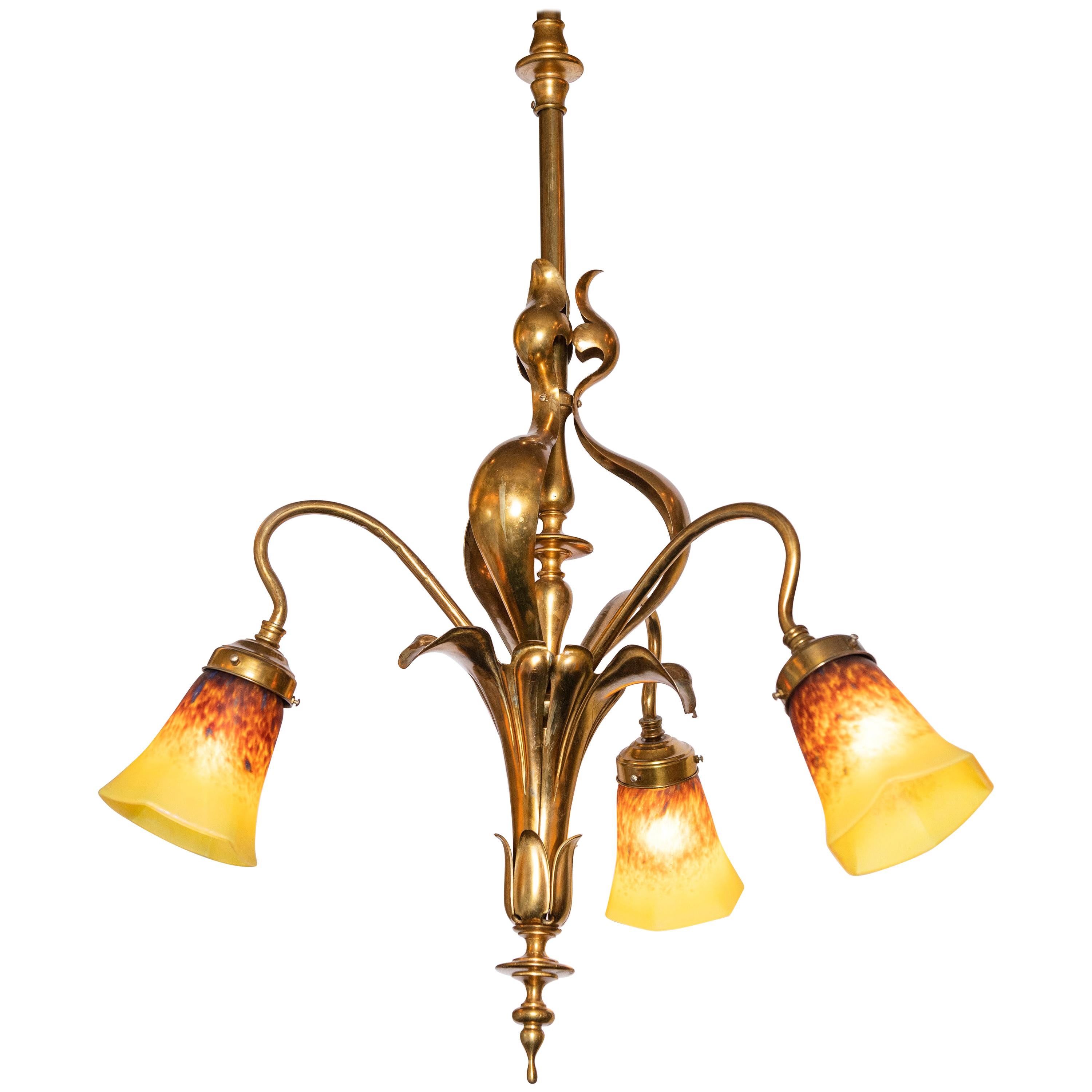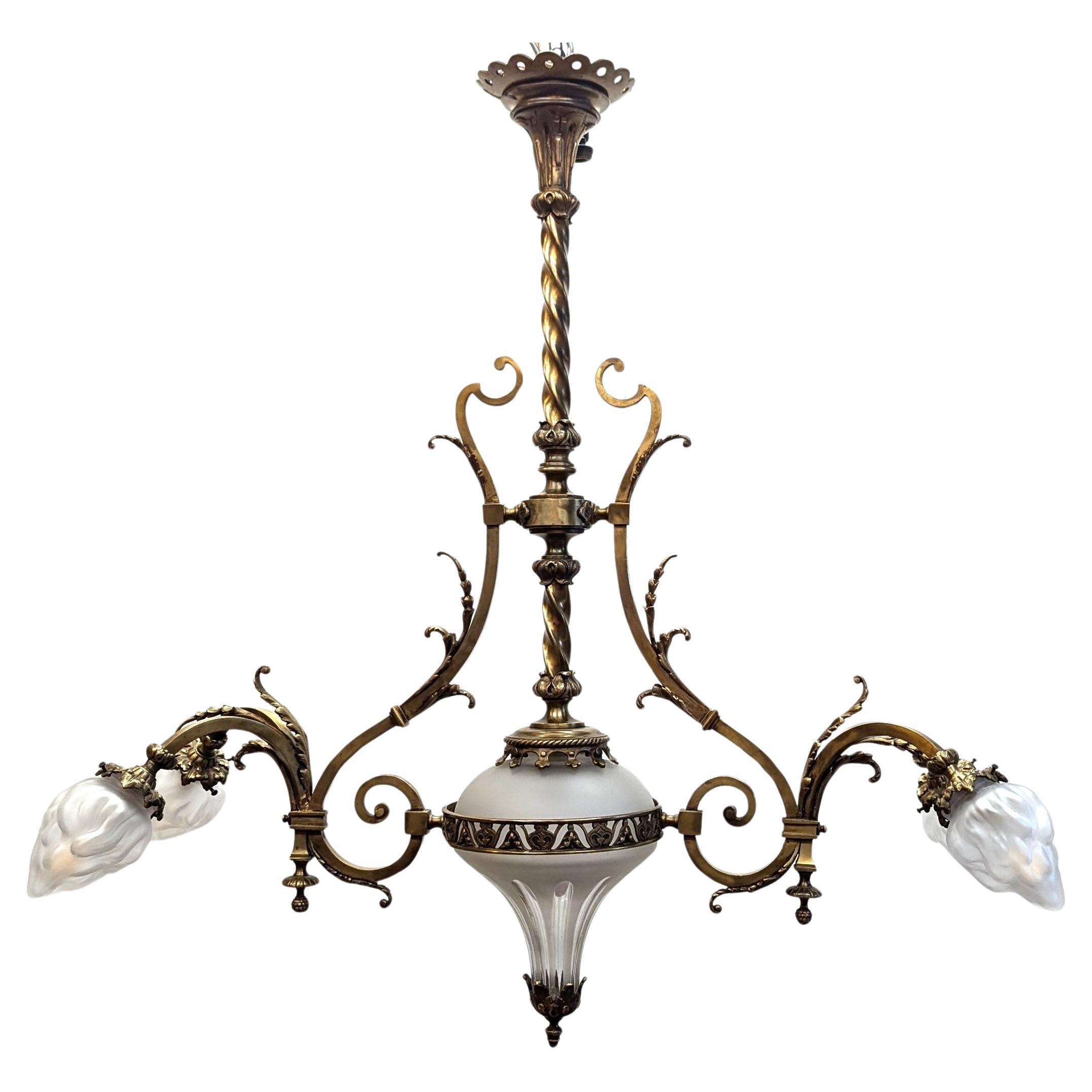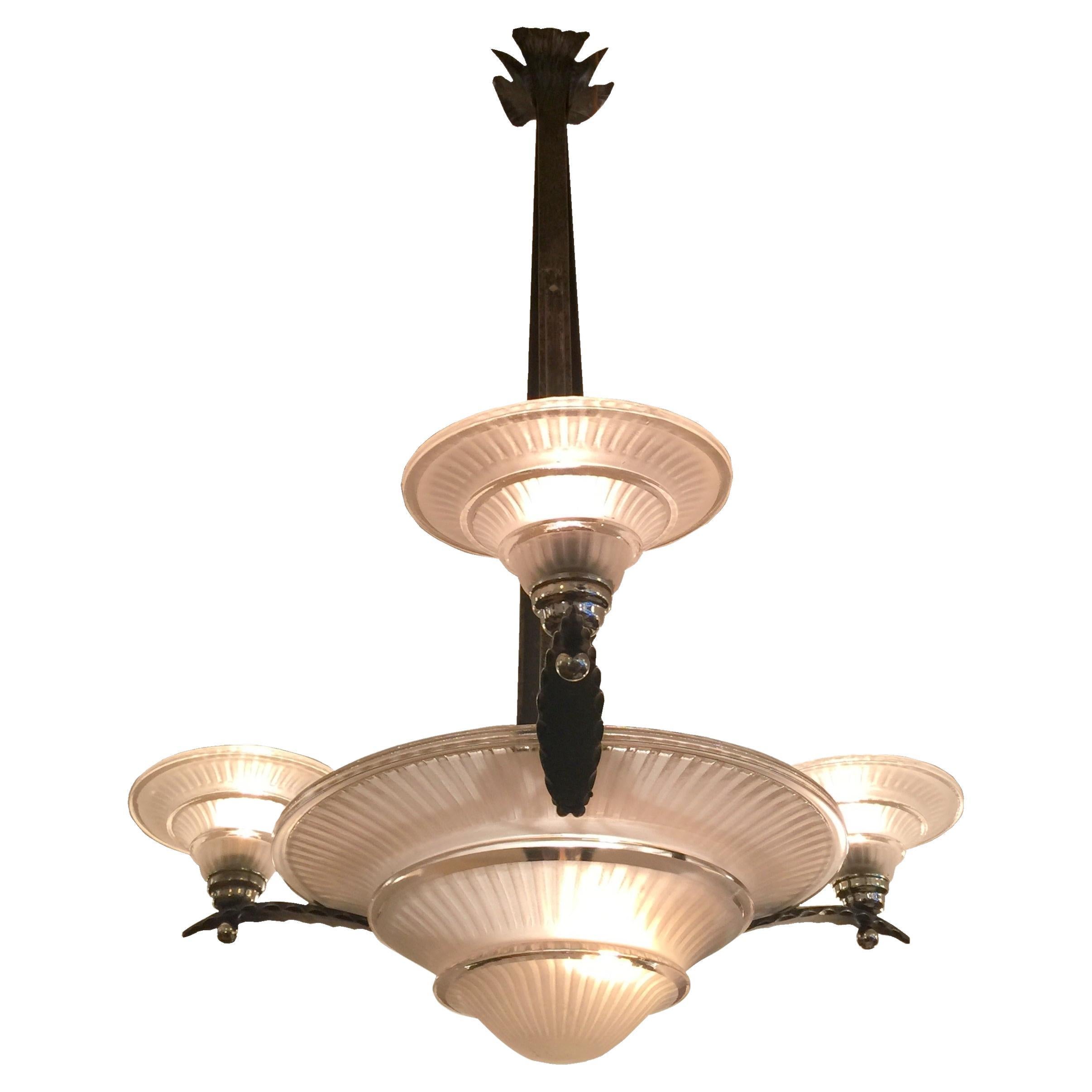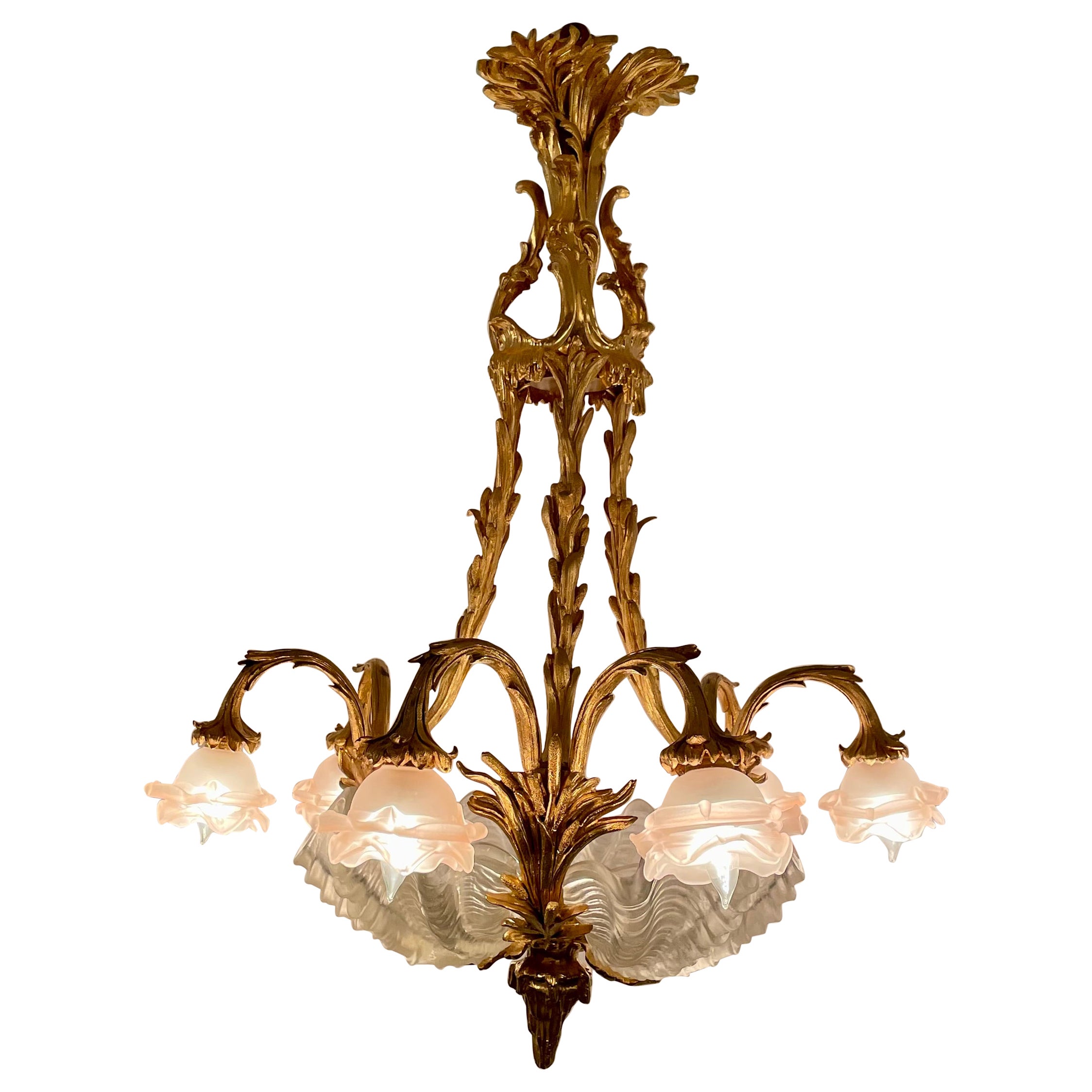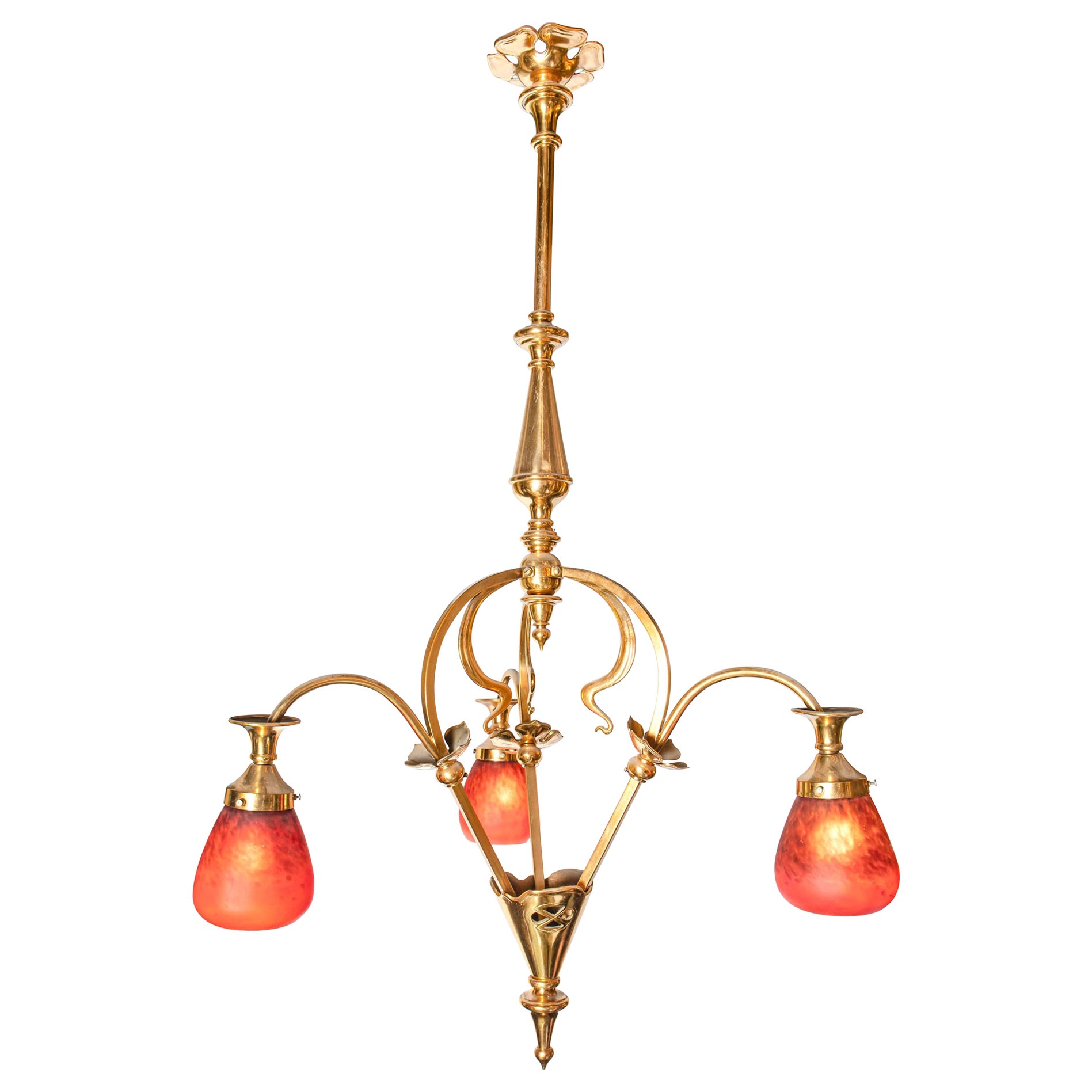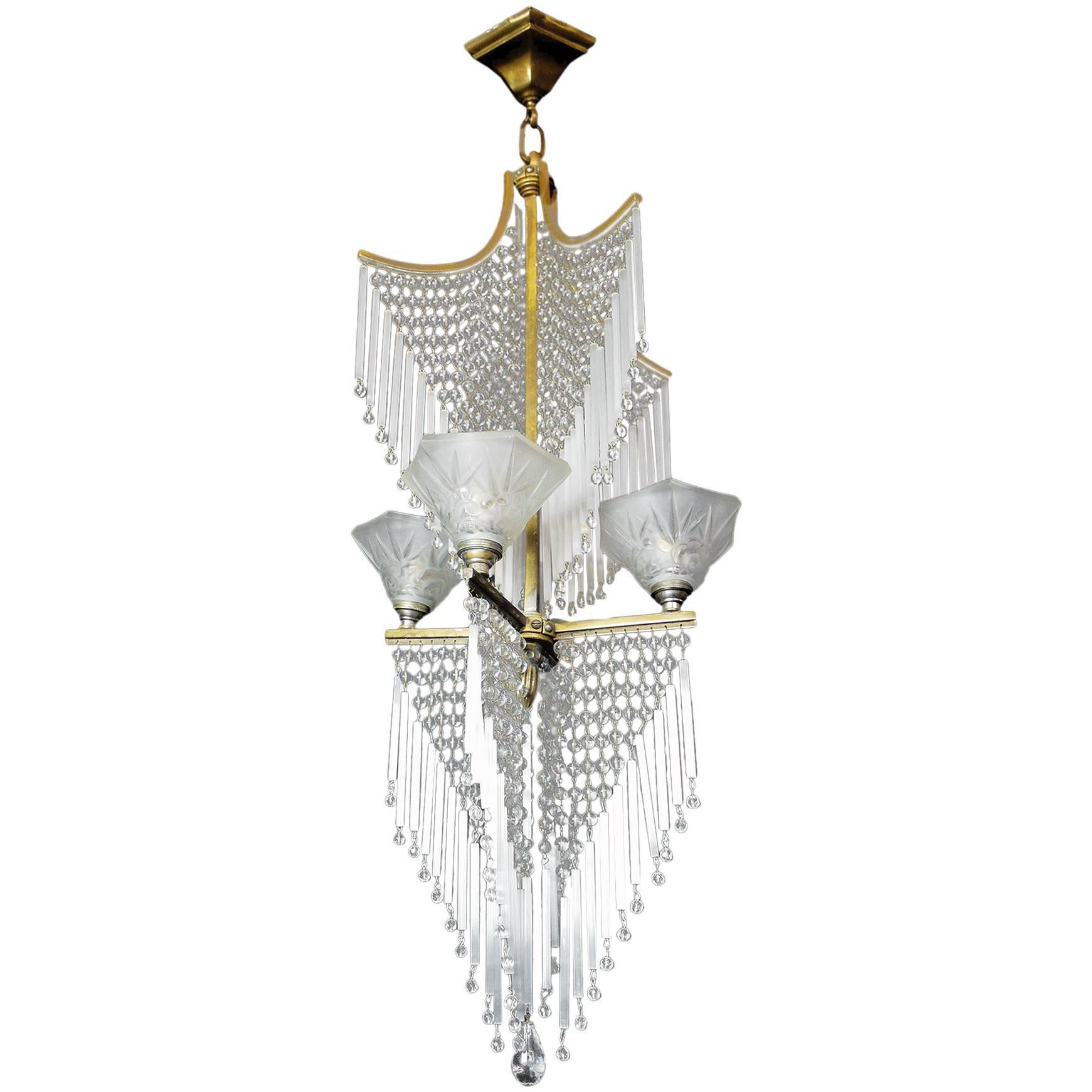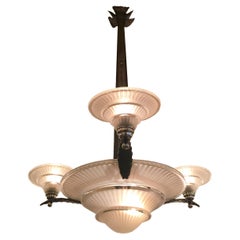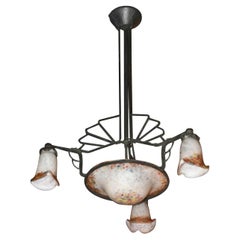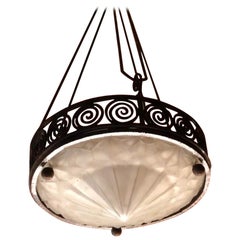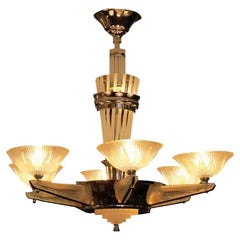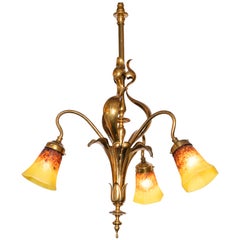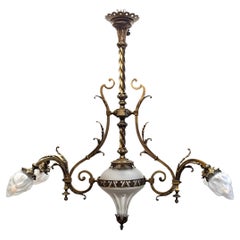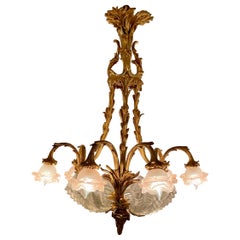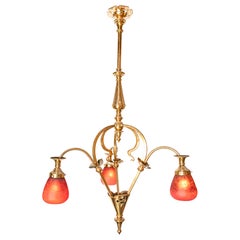Items Similar to Monumental Chandelier Art Nouveau Glass Daum Nancy attributed to Louis majorelle
Video Loading
Want more images or videos?
Request additional images or videos from the seller
1 of 6
Monumental Chandelier Art Nouveau Glass Daum Nancy attributed to Louis majorelle
$60,000
£44,522.33
€51,862.41
CA$83,520.44
A$93,007.54
CHF 48,405.28
MX$1,146,771.72
NOK 616,478.31
SEK 579,429.85
DKK 386,957.93
Shipping
Retrieving quote...The 1stDibs Promise:
Authenticity Guarantee,
Money-Back Guarantee,
24-Hour Cancellation
About the Item
Amazing hanging lamps in bronze
Style: Art Nouveau and Modernism or Jugendstil
Year: 1915
Material: bronze,
If you are looking for sconces to match your ceiling lighting, we have what you need.
Pushing the button that reads 'View All From Seller'. And you can see more objects to the style for sale.
Attributed to Daum Nancy Glass
Daum is the name of a factory established in 1875 in the city of Nancy, France. When the notary Jean Daum became the owner of an industrial furnace, that of Nancy Glass, to expropriate the owners who were heavily indebted to him and was not able to return the money to cover the liabilities of management. So the company was launched with the aim of both renewable and guide it through changes in period, style and taste. The eldest son Auguste, despite having studied law, became director of the factory, which for the moment out glasses, jugs, glass commonly used low-quality glass for watches. The first thing I did was start producing table glassware of good quality and then in a second phase, around 1890, he formed an art department under the direction of his brother Antonin. At that time did not establish any particular innovation in style, but had a great influence of his friend, neighbor and professor Emile Galle. At the beginning of the last decade of last century, the glass gradually begins to lose transparency, the decor is based solely on flowers, plants and animals, and parts enriquecencon metal elements. Colors were used in two or three layers, in which, by the technique of carving, was carved decoration. The decor-interleaved, is situated within the genre of the search for perspective. Patented in June 1899, is to perform a piece with several layers, of which the interior is decorated (to the tooth, the enamel and acid), and then reheated to 1000 BC and covered with another layer. The colors stood out to be more blurred and less distinct lines, which gives the interior a more pleasing and unobtrusive. At the Universal Exhibition of Paris of 1900, presented 38 pieces made by this technique, the success was brilliant and they were awarded Daum do the Grand Prix, as well as Galle. From the beginning of the century it shows a dedication to progressive non-figurative decoration, based on the color scheme. In 1908 an exhibition was presented at the first pitcher in the series known for jade céramique, in which the piece, performed with the technique of vitrification of powder, was coated on a transparent glass layer. By 1906 Antonin Daum began to present its first pallet verre (glass paste) made by Walter Almric. Each artist had a proprietary formula for the preparation of the glass portion, of course secret, which explains the enormous difference in the results. With glass pastes for expanded collaboration with Daum Majorelle, which even it was given a small plate for incorporation into the furniture. The collaboration continued growing profitably, even in the field of lamp production. The Nancy Glass had already been affirmed important developments and could pick up hard-won success. But not for long, since the explosion of the first world war forced the closure of the furnaces, when they were reopened at the end of the conflict, the world and taste had changed profoundly.
Attributed to Louis majorelle
Louis Majorelle
French cabinetmaker and decorator, a leading member of the "Nancy School" founded by Emile Galle in 1901. Son of Auguste Majorelle, a specialist in eighteenth-century reproductions, studied painting at the School of Fine Arts in Paris under the direction of Jean-Françoise Millet. On the death of his father, back to Nancy to take over the family business. By 1890, he left the reproductions and influenced by Gallé start creating Art Nouveau furniture. Majorelle furniture had, less naturalistic features than those of Gallé, abstract drawings often proposed, and combined with walnut ¬ ras made exotic mahogany, tamarind in linear strips or boxes that were undulating contours, also used metal applications in contrast wise perfectly smooth surfaces and dense simi ¬ lar to marbled waves and waters in ¬ creped on which appeared the two butterflies fluttering dragonflies-arranged with locks. Majorelle, in order to control the object in its spatial development and volume, prepared their models in clay pieces before passing the carpenter In 1900 exposed to the lounge and library for the Universal Exhibition of Paris, and obtained great success through her works inspired by nature, added to its machine shop and combining his work with labor to marquetry, carvings, sculpture, ... able to increase production and reduce the price. His furniture and finely polished brass sconces, and stylized botanical motifs are characteristic. After the first World War, goes back to work and adapt to new trends in the Art Deco. At his death, the business passed to his pupil Alfred Lévy.
To take care of your property and the lives of our customers, the new wiring has been done.
We have specialized in the sale of Art Deco and Art Nouveau styles since 1982.If you have any questions we are at your disposal.
Why are there so many antiques in Argentina?
In the 1880 – 1940 there was a grate wave of immigration encouraged by the periods of war that were taking place.
1st World War took place between 1914 and 1918
2nd World War took place between 1939 and 1945
The immigrants options were New York or Buenos Aires. Tickets were cheap and in Buenos Aires they were welcomed with open arms, as it was a country where everything was still to be done.
Argentina was the country of new opportunities, labour was needed and religious freedom was assured, in many cases the of the family travel first until they were settled and then the rest of the family members join them.
In the immigrant museum “Ellis Island Immigrant Building” in New York you can se the promotional posters of the boats that would take them to a new life.
Between the years 1895 and 1896, Argentina had the highest DGP (gross domestic product) per capita in the world according to the Maddison Historical Statistics index, this situation arose due to the large amount of food being exported to European countries, which were at war.
The Argentinean ships left the port of Buenos Aires with food, but they returned with furniture, clothes and construction elements, (it´s common to see this the old buildings of the historic neighbourhood of San Telmo, the beams with the inscription “Made in England)”, as well as many markets that were built in Buenos Aires, such us the San Telmo Market, whose structure was brought by ship and afterwards assembled in 900 Defensa Street.
With the great influence of European immigrants living in the country, the children of the upper classes travelled to study in France, resulting in the inauguration of “La Maison Argentinienne”, on 27th of June 1928, in the international city of Paris, which hosted many Argentinians that were studying in Frace.
It´s the fourth house to be built after France, Canada and Belgium, being the first Spanish-speaking one. Still in place today (17 Bd Jourdan, 75014, Paris, France). Many of the children of these wealthy families who attended international art exhibitions, museums and art courses abroad, took a keen interest in the European style. This is why Buenos Aires was at the time referred as “The Paris of South America”.
Between the years 1890 and 1920 more than a hundred Palaces were built on Alvear Avenue the most exclusive avenue in Buenos Aires. Today some of these palaces have been transformed into museums, hotels and embassies.
In the year 1936, the Kavanagh building was inaugurated, it was the tallest reinforced concrete building in South America.
During 1994 the American Society of Civil Engineers distinguished it as an “international engineering milestone”, and it´s now considered a World Heritage of Modern Architecture.
At the time was common to hire foreign architects such as Le Corbusier, who visited Buenos Aires/Argentina in 1929 and in 1948 he drew up the blueprints for a house built in La Plata City (which was declared a World Heritage Site).
In 1947, the Hungarian architect Marcelo Breuer designed “Parador Ariston” in the seaside city of Mar del Plata. After an Argentinean student at Harvard University convinced him to come to Argentina. He worked on an urban development project in the Casa Amarilla, area of La Boca.
The Ukrainian architect, Vladimiro Acosta, arrives in Argentina in 1928 and worked as an architect until que moved to Brazil.
Antonio Bonet, a Spanish architect who worked with Le Corbusier in Paris, arrives in Argentina in 1937, where he carried out several architectural works and in 1938 designs the well-known BFK chair.
Andres Kálnay, of Hungarian origin, made around 120 architectural masterpieces, among which the former Munich brewery stands out, he even made the furniture’s design.
The German architect, Walter Gropius, director of the Bauhaus, lived in Argentina, where he wrote articles for “Sur” magazine and founded in Buenos Aires, an architectural firm with Franz Möller, who was also an architect, where he built two houses.
At the same time several famous designers decided to immigrate to Argentina, among them we can find the well-known French designer, Jean-Michel Frank, who arrived in the country in 1940 and also worked for the Rockefeller family.
Special pieces were made, which were sold exclusively in the country, such as the well-known German company “WMF”, who sold their products by catalogue, which were chosen by the ladies of high society in the list of wedding gifts, as well as the pieces designed by Christofle.
The Swiss sculptor Alberto Giacometti, made special pieces for Argentinean mansions.
In 1904 the first Jansen branch outside Paris was established in Buenos Aires, as the Argentinean clientele demanded a large amount of furniture, from the end of the 19th century to the mid-20th century.
In 1970, the brand Rigolleau Argentina made pieces authorised by Lalique.
The brands Maple and Thompson also set up shop in the country.
The French plastic artist, Marcel Duchamp moved to Argentina in 1918-1919.
Glass signed Gallé, Charder, Leverre, Schneider, Muller and other French firms. They were bought in flower shops and were given to ladies with beautiful floral arrangements.
Some furniture manufacturers travelled to international fairs and bough the patterns to produce the furniture in Argentina, such as the furniture firm Englander and Bonta, who bought the patterns ins Italy.
It is worth mentioning that in Argentina we have the largest community of Italians outside of Italy, as it is estimated that 70 percent of the inhabitants have at least one Italian descendant, followed by Spanish immigrants.
The most Important furniture stores in Argentina:
Comte is founded in 1934 (under the direct management of Jean Michel Frank in 1940).
Nordiska (Swedish company established in 1934).
Churba in 1960, a company that brought foreign designers to present their furniture in the country:
Denmark: (Arne Jacobsen, Finn Juhl, Bender Madsen, Ejner Larsen, Poul Kjaerholm, Hans Wegner)
Sweden: (Hans Agne Jakobsson, Gustavsberg)
United States: (Herman Miller)
Finland: (Lisa Johansson, Folke Arstrom, Tapio Wirkkala, Alvar Aalto, Timo Sarpaneva)
Swedish Factory: (Orrefors)
Italy: (Littala, Vico Magistretti, Emma Gismondi, Gae Aulenti, Angelo Mangiarotti, Elio Martinelli, Gianna Celada, Angelo Mangiarotti, Mario Bellini, Carlo Scarpa)
Finland: (Olivia Toikka)
Plata Lappas (Lappas Silver): a goldsmith shop founded in 1887 in Argentina by Alcibiades Lappas of Greek origin.
In 2019, in Argentina took place “the Art Deco world congress”, in which we participated as hosts invited by Geo Darder, founder of the Copperbridge – Foundation, in which prominent people from all over the world attended to learn about Art Deco in Argentina.
Argentina currently has more than 100 Art Deco buildings and another 90 Art Nouveau buildings throughout the city of Buenos Aires.
Argentina is a country that has not been involved in many wars, which is why it has been a refuge for works of art and antiques from different periods of time, unlike European countries. That is way many collectors, museums and antique dealers from all over the world visit it, you should not miss the opportunity to visit this great country.
Laura Guevara Kjuder, architect.
- Dimensions:Height: 55.12 in (140 cm)Diameter: 35.44 in (90 cm)
- Power Source:Hardwired
- Voltage:220-240v
- Lampshade:Not Included
- Style:Art Nouveau (Of the Period)
- Materials and Techniques:
- Place of Origin:
- Period:1910-1919
- Date of Manufacture:1915
- Condition:Rewired: To take care of your property and the lives of our customers, the new wiring has been done. Wear consistent with age and use.
- Seller Location:Ciudad Autónoma Buenos Aires, AR
- Reference Number:Seller: L-HL-1981stDibs: LU6785228693572
About the Seller
5.0
Vetted Professional Seller
Every seller passes strict standards for authenticity and reliability
Established in 1982
1stDibs seller since 2022
36 sales on 1stDibs
Typical response time: <1 hour
- ShippingRetrieving quote...Shipping from: Ciudad Autónoma Buenos Aires, Argentina
- Return Policy
Authenticity Guarantee
In the unlikely event there’s an issue with an item’s authenticity, contact us within 1 year for a full refund. DetailsMoney-Back Guarantee
If your item is not as described, is damaged in transit, or does not arrive, contact us within 7 days for a full refund. Details24-Hour Cancellation
You have a 24-hour grace period in which to reconsider your purchase, with no questions asked.Vetted Professional Sellers
Our world-class sellers must adhere to strict standards for service and quality, maintaining the integrity of our listings.Price-Match Guarantee
If you find that a seller listed the same item for a lower price elsewhere, we’ll match it.Trusted Global Delivery
Our best-in-class carrier network provides specialized shipping options worldwide, including custom delivery.More From This Seller
View AllChandelier Jugendstil, Art Nouveau, in Glass and Iron, Year 1900, Country French
Located in Ciudad Autónoma Buenos Aires, C
Chandelier Jugendstil, Art Nouveau, Liberty
Year: 1900
Country: French
Glass and Iron
It is an elegant and sophisticated Chandelier
We have specialized in the sale of Art Deco...
Category
Antique Early 1900s French Art Nouveau Chandeliers and Pendants
Materials
Iron
Chandelier Schneider, French, Style Jugendstil, Art Nouveau, Liberty, 1900
By Charles Schneider
Located in Ciudad Autónoma Buenos Aires, C
Hanging lamp Schneider
Material: art glass and Iron
Style: Art Nouveau
Country: French
To take care of your property and the lives of our customers, the new wiring has been done.
If...
Category
Antique Early 1900s French Art Nouveau Chandeliers and Pendants
Materials
Iron
Chandelier , French, Style Jugendstil, Art Nouveau, Liberty, 1900
Located in Ciudad Autónoma Buenos Aires, C
Hanging lamp Schneider
Material: art glass and Iron
Style: Art Nouveau
Country: French
To take care of your property and the lives of our customers, the new wiring has been done.
If...
Category
Antique Early 1900s French Art Nouveau Chandeliers and Pendants
Materials
Iron
Chandelier Sign "C. Leleu" Jugendstil, Art Nouveau, 1900
Located in Ciudad Autónoma Buenos Aires, C
Hanging lamp Sign "C. Leleu"
Material: Chromed and Art Glass
Style: Art Deco
Country: France
To take care of your property and the lives of our customers, the new wiring has been d...
Category
Antique Early 1900s French Art Nouveau Chandeliers and Pendants
Materials
Chrome
Chandelier Jugendstil, Art Nouveau, in Glass and Iron, Year 1900, Country French
Located in Ciudad Autónoma Buenos Aires, C
Chandelier Jugendstil, Art Nouveau, Liberty
Year: 1900
Country: French
Glass and Iron
It is an elegant and sophisticated Chandelier
We have specialized in the sale of Art Deco and A...
Category
Antique Early 1900s French Art Nouveau Chandeliers and Pendants
Materials
Iron
Monumental Chandelier in Alabaster, Art Nouveau or Modernism or Jugendstil
Located in Ciudad Autónoma Buenos Aires, C
Amazing hanging lamps in alabaster
If you have problems to the height, We can cut the Barral, at the indicated height (free of charge)
Year: 1915
Material: alabaster
To take care ...
Category
Vintage 1910s French Art Nouveau Chandeliers and Pendants
Materials
Alabaster, Chrome
You May Also Like
Bronze and Artistic Glass Chandelier, France, Early 20th Century
Located in Buenos Aires, Buenos Aires
Bronze and artistic glass chandelier, Art Nouveau style, France, early 20th century.
Schneider glass tulips.
Three lights.
Category
Early 20th Century French Art Nouveau Chandeliers and Pendants
Materials
Bronze
Antique French Brass & Glass Art Nouveau Chandelier
Located in New York, NY
Antique French Brass & Glass Chandelier, Art Nouveau Turn of the century.
Spectacular Chandelier of solid brass, gilt bronze details, with molded and cut glass. Stunning chandelier...
Category
Antique Early 1900s French Art Nouveau Chandeliers and Pendants
Materials
Brass, Bronze
Antique French Art Nouveau Bronze D'ore Chandelier, Circa 1910.
Located in New Orleans, LA
Antique French Art Nouveau bronze d'ore chandelier, circa 1910.
Category
Early 20th Century French Art Nouveau Chandeliers and Pendants
Materials
Bronze
Bronze and Artistic Glass Chandelier, France, Early 20th Century
Located in Buenos Aires, Buenos Aires
Bronze and artistic glass chandelier, Art Nouveau style, France, early 20th century.
Schneider glass tulips.
Three lights.
Category
Early 20th Century French Art Nouveau Chandeliers and Pendants
Materials
Bronze
French Art Nouveau Chandelier by Lorrain / Daum
By Lorrain
Located in Niederdorfelden, Hessen
Elegant and very rare chandelier with four frosted shades in molded-pressed glass with glass beads and rods in the manner by Lorrain/Daum (Paul Daum & Pierre D'Avesn), Nancy, France....
Category
Vintage 1910s French Art Nouveau Chandeliers and Pendants
Materials
Crystal, Bronze
$4,720 Sale Price
20% Off
Beautiful Art Nouveau Chandelier Antique Austria Vienna, 1910s
Located in Nuernberg, DE
Petite Art Nouveau chandelier. Functions as is with three E27 / 110 Volt light bulbs. Can take up to 60 Watts each bulb. Beautiful bronze metal chandelier. Found at an estate sale in...
Category
Vintage 1910s Austrian Art Nouveau Chandeliers and Pendants
Materials
Metal
More Ways To Browse
French Religious Gold Pendant
Art Nouveau Jade
Antique Pallet
Antique Pallets
Art Nouveau Jug
Antique Gold Dining Chair
German Plant Table
Watches 1945
Giacometti Sconces
Spanish Library Table
Swedish Plant Stand
Established And Sons Lamp
Antique Religious Pendants
Antique Miller Table Lamps
Daum Antiques
Art Nouveau Marquetry Table
Art Deco Expandable Table
Polish War Poster
